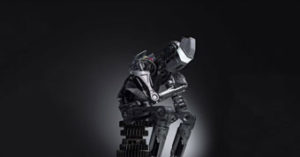10 May 2018 (Sliema, Malta) – Where does the mind end and the world begin? Is the mind locked inside its skull, sealed in with skin, or does it expand outward, merging with things and places and other minds that it thinks with? What if there are objects outside—a pen and paper, a phone—that serve the same function as parts of the brain, enabling it to calculate or remember? You might say that those are obviously not part of the mind, because they aren’t in the head, but that would be to beg the question. So are they or aren’t they?
How is it that human thought is so deeply different from that of other animals, even though our brains can be quite similar? The difference is due to our heightened ability to incorporate props and tools into our thinking, to use them to think thoughts we could never have otherwise. If we do not see this, it is only because we are in the grip of a prejudice– that whatever matters about my mind must depend solely on what goes on inside my own biological skin-bag, inside the ancient fortress of skin and skull.
These are the kinds of questions we discussed at the AI “Think Fest” in Sicily this week. Presenting were a brain trust of philosophers, cognitive scientists, neuroscientists, computer scientists, cybersecurity analysts, etc. It was an invitation from the sponsor, my long-term media client, Microsoft, but it was not company specific, but a very agnostic approach. It was a wonderful mash-up of various disciplines in the area of cognitive science (neuroscience, psychology, linguistics, A.I., robotics) and in distant fields beyond.
Neither was it all “high-end” philosophy. There was a deep look at the psychographic targeting work of Palantir ….
… who make the boys at Cambridge Analytica look like a bunch of Boy Scouts.
Plus some very, very good chats on artificial intelligence and disruptive AI trends and where we are vis-a-vis the immense amount of AI hype, what’s driving AI market dynamics, and the AI reality.
And we had the chance to revisit the work of such pioneers as Mark Weiser who had written nearly 3 decades ago (he was then chief scientist at Xerox PARC, whose technology Steve Jobs would “borrow” to eventually launch the iPod and iPhone) …
It was his influential paper that predicted a future in which computing would soon be omnipresent.
Obviously, much to write about and all the material freely available for repurposing and posting. In this post, just one brief share: a deep-learning algorithm that spontaneously mimicks the activity of specialized neurons that tell us where we are in space. Much of this has already been published in Nature magazine, and more will be published, so herein a quick synopsis:
Grid cells. Ya gotta love them.
Scientists have used artificial intelligence to recreate the complex neural codes that the brain uses to navigate through space. The feat demonstrates how powerful AI algorithms can assist conventional neuroscience research to test theories about the brain’s workings — but the approach is not going to put neuroscientists out of work just yet, say the researchers. It really was a very striking and remarkable convergence of form and function. The computer program was developed by neuroscientists at University College London (UCL) and AI researchers at the London-based Google company DeepMind. It used a technique called deep learning — a type of AI inspired by the structures in the brain — to train a computer-simulated rat to track its position in a virtual environment.
The program surprised the scientists by spontaneously generating hexagonal-shaped patterns of activity akin to those generated by navigational cells in the mammalian brain called grid cells. Grid cells have been shown in experiments with real rats to be fundamental to how an animal tracks its own position in space. What’s more, the simulated rat was able to use the grid-cell-like coding to navigate a virtual maze so well that it even learned to take shortcuts. Neuroscientist Edvard Moser is one of the pioneers, having shared the 2014 Nobel Prize in Physiology or Medicine for his co-discovery of grid cells and the brain’s other navigation-related neurons. So to him it was striking that the computer model, coming from a totally different perspective, ended up with the grid pattern we know from biology. The work is a welcome confirmation that the mammalian brain has developed an optimal way of arranging at least this type of spatial code.
Having just finished a neuroscience program at the University of Cambridge, I find all of this fascinating because it goes to the issue of analysing the inner workings of deep-learning systems and whether there is a universal computational principle that aids spatial navigation. The research and study sets out to use deep-learning networks — which are based on recurrent computational units that communicate with each other — to test a hypothesis in neuroscience: that the brain, using grid cells, maps its position in an environment by integrating information about the speed and direction of the body’s movement.
First, the researchers generated data to train their algorithm. They simulated pathways taken by virtual rats as they foraged in enclosures, as well as the activity of place and head-direction cells as the simulated rodents moved around — but not of grid cells. They then used these data to train the deep-learning networks to recognize the position of the simulated rats. As the researchers did so, they found that hexagonal patterns of grid-like activity emerged spontaneously in the computational units — just as they do in the brains of real rats in lab experiments.
The scientists were also intrigued to find that they needed to tweak the system to add some artificial noise — making its units tick more similarly to those in the brain — to get the grid-like activity to emerge. This is something theoretical neuroscientists have been thinking about, but also couldn’t test until now.
Then the researchers put the system through its paces, testing whether virtual rats could use it to navigate. They placed the simulated rodents in a larger enclosure designed as a maze, where the virtual rats had to learn to make their way to a specific goal. The researchers added another program to the system that introduced the memory and reward functions necessary for learning. The simulated rats soon learned to find their goals through trial and error, and became so proficient that they outperformed a human expert who attempted the same task, and they also started to take shortcuts.
The collaboration with neuroscientists has inspired AI research, says DeepMind researcher and study co-author Andrea Banino. But right now it is purely basic research into making intelligent algorithms, and not about applications. Well, not yet, anyway. Researchers agree that AI will be a useful tool for testing hypotheses about the brain, but that it is unlikely to answer questions about how and why the brain comes to use a particular code. It seems that AI may be able to accelerate our research into how the brain navigates but it won’t usurp neuroscientists just yet.
To recap
So what we have is a program developed using architectures similar to those found in the human brain. The neural network has developed something similar to the “grid cells” found in a biological brain, which seem to provide a way for an animal to position itself in physical space.
And why it matters is the research suggests that grid cells play a big role in how animals—including humans—find their way around the world. This discovery will eventually have significant practical benefits, like helping robots navigate through unfamiliar buildings, high-level medical apps — and something more prosaic, improving navigation on your smart phone.



